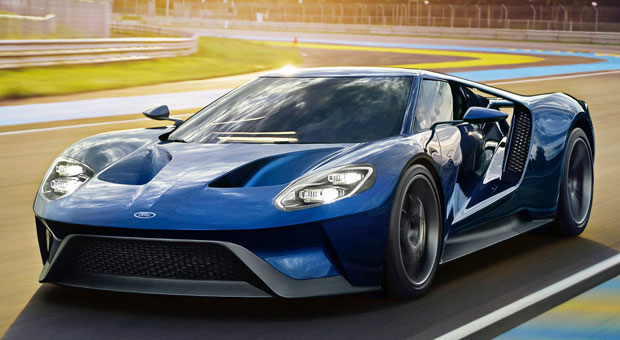Two interesting events took place this month. Tesla announced its Model 3, a relatively affordable electric car, and it attracted around 180K preorders on the same day. That was before the company actually revealed the car. There were more than 250K preorders in the first 36 hours. Oh, and the run rate is about 1,500 per hour of preorders for this car right now.
To be clear, that means a huge number of people now have deposits down on a car they likely won’t get until late next year.
Ford opened preorders for its new Ford GT, and only 500 people actually will get to buy this US$400K car — and as of right now, you still can order one of those 500. There have been no lines for this arguably even more amazing car.
It likely cost more to develop the Ford GT than it did to develop the Model 3, and assuming it sells them all, Ford will make a total of around $200M. By the time it ships the Model 3, Tesla should have at least 500K preorders at an average price of around $40K each. That’s about $20B in revenue.
Considering that virtually no one who is in the market for a Ford GT would consider a Tesla anything as an alternative, but that just about everyone who is putting down a deposit for a Model 3 might have bought a Ford instead, you start to see a problem for Ford — and likely the rest of the auto industry — if and when Apple enters the competition.
Once they reach scale, Apple-like car companies could roll over the existing auto companies like Apple and Google rolled over then-dominant cellphone companies Nokia, Palm and BlackBerry. I’ll explain and then close with my product of the week: a new Kindle from Amazon.
Tesla/Apple Business Approach
Tesla effectively copied Steve Jobs’ business model when he built Tesla. What makes this model different is that rather than focusing on providing a choice, the Apple model focuses on driving a decision. You can see that if you compare Apple to pretty much any other tech vendor.
Particularly while Jobs was running the company, Apple provided little product variety but spent a relatively high amount on marketing, so people wanted the few products that Apple shelved. While Tim Cook has drifted away from this a bit, Tesla is still a company that has very few choices but creates a clear path to the one or two cars that it carries. The cars are made to order, but you get comparatively few choices.
As a result, Tesla builds to order and doesn’t carry any inventory except for a limited number of refurbished used cars. This is very different from a typical car company that literally can have huge fields of unsold cars at any given time waiting for someone to buy them.
Tesla isn’t fully profitable yet — but if you look at Apple, it maintains the highest profits in the technology industry. It was the most highly valued company in the world at the end of last decade — regardless of industry — which speaks to just how well the Apple model can work with a mature company.
When Apple entered the cellphone and MP3 markets, those markets were dominated by firms far more powerful than Apple was at the time. Yet Apple rolled right over them. Two of the most powerful, Palm and Research In Motion, were so badly hurt that one went out of business and the other had to change its business model dramatically in order to survive.
In fact, both industries went through massive changes. Record labels were subordinated to iTunes, and there was a major shift in customer ownership from the cellphone carriers to Apple.
When all is said and done, Apple and Tesla customers are now the most loyal in their respective industries. With the Model 3, Tesla is showcasing that it can get lines for its new product, just like Apple could, and it is looking pretty scary at the moment.
That doesn’t bode well for an industry that hasn’t seen a line for a car since the 1991 Miata — and never the kind of advanced demand the new Tesla is showcasing. Think about it. Rarely do you have to wait more than three months for a car you order, but these Tesla 3 buyers are, en masse, waiting more than a year for theirs — with no certainty it will show up even then.
Granted, Tesla could stumble — but so far, betting against Elon Musk (Tesla’s CEO) has been a fool’s game. Competitors believed Apple would stumble with both the iPod and iPhone, and that didn’t turn out so well for them.
Ford’s – and the Auto Industry’s – Problem
Like the music industry before the iPod and the mobile phone industry before the iPhone, the car industry hasn’t been very flexible. It still uses a dealership model, which tends to create a lot of separation between the customer and the car builder.
The dealers tend to own the customer, not the car company, and car companies put out lots of different cars that they generally can’t afford to market very well — at least, not individually. That increases costs associated with excess inventories, lowers customer satisfaction with the vehicles, and makes it increasingly hard to sustain customer loyalty.
Apple caught the cellphone industry napping and — along with Google, which basically fielded a series of cheap iPhone knock offs — changed that massive industry. Tesla and Apple have the same potential in the auto market.
I’m not sure the car companies even see it. They may look at the Tesla Model 3 preorder lines like the cellphone companies looked at the initial iPhone demand — like a fluke. They may argue that this isn’t the way things are done, and that Tesla will fail. Certainly, that is what was said about Apple — but look how that turned out.
Wrapping Up
When an industry like the telecommunications industry or the auto industry has been around for a long time, the difficulty is that it tends to become inbred. In other words, the same people move from company to company. That creates a feeling of willingness to explore new things, but in reality they’re just forming a large bloc of folks who can’t see change and don’t want it.
Tesla is using the same techniques Apple used to surprise the telecommunications industry. The huge preorder numbers for the Model 3 suggest a level of disruption — once this new class of company reaches scale — that could put firms like Ford and Toyota out of business, particularly if Apple and Google both join Tesla in the car market, as rumored.
Unless the traditional car companies step up their defenses substantially, they’ll likely have a lot in common with Palm and BlackBerry at the end of this cycle, which suggests several of them will have to exit the car market as a result. That will be a shame — particularly since they got nearly a decade’s worth of warning.
I’ve been a Kindle fan since I bought the first Kindle that came out, and it is kind of strange the way this line has evolved. Originally it was just an ePaper product, but it came with lifetime wireless connectivity to cell data services — slow but adequate for books — that eventually worked nearly worldwide. That gave it a unique combination of massive battery life and free connectivity that nothing else in the market could touch.
Since then, Amazon has focused mostly on its Fire line, which is a more full-featured tablet, and moved away from its ePaper offerings. While we gained movies, better Web experiences, and color, we went from days to hours of battery life, and we lost the free ubiquitous connectivity.
With the Kindle Oasis, Amazon once again is refreshing the ePaper design. There’s no color, but it offers hours to possibly months of battery life, as well as outdoor viewing capability. There is even an option that offers nearly unlimited data, so you can get an experience much more similar to that first Kindle.

Except for the part that holds the battery, this version of the Kindle is exceptionally thin and light, and likely ideal for power readers. One loss I question though is that this version of the ePaper reader isn’t water resistant like its lower-cost brother.
This, combined with the much higher price, suggests the older Kindle Voyage may be the better deal for any but the most avid reader, for whom the massive additional battery life and better night lighting would make a significant difference.
Personally, I think Amazon should have made this version larger and built in the water resistance, for the price, but this is still arguably the best ePaper reader in the market. For those who want that distinction, the Kindle Oasis should fit their needs nicely, and that’s what makes it my product of the week.

























































Presently Ford has received over 5,000 applications for the GT. The GT is a race car and is not intended to make a profit, unlike the 3. It is being offered for sale to comply with the rules for the racing category (and hopefully to help pay back some of the investment). Also, the majority of people who plunked down $1,000 for a 3 will be waiting 2-3 years before they will see their car, unless large numbers of people ahead of them decide not to follow through with their purchase. All GT buyers will see their car by the end of next year.
The key for Tesla is whether 1) they can they scale up production and 2) become profitable, because make no mistake, Tesla is not profitable now and won’t be until they have earned enough margin to "pay back" the billions invested to date.